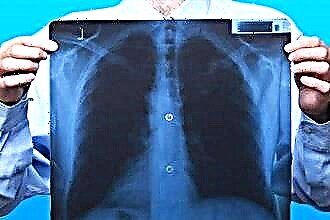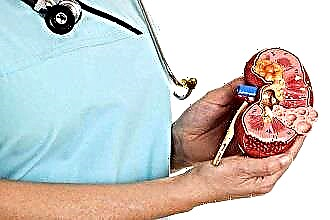Sore throat is a classic symptom of infectious and inflammatory lesions of the mucous membrane of the pharynx and tonsils, which occurs in patients of all age groups. However, with viral, bacterial, fungal pharyngitis and tonsillitis, it is usually bilateral in nature. Situations when the tonsil hurts on one side are much less common and can be triggered by both infectious and non-infectious factors. It is important to establish a diagnosis in a timely manner and choose a treatment - this will help to avoid dangerous complications. To do this, you should have an idea of why there is pain on only one side.
Causes
 Pain is a symptom that cannot be called specific. It appears in many diseases; listing the pathologies that are inherent in pain, it is worth immediately mentioning almost all medical disciplines without exception. If you think about the main characteristics of pain syndrome with angina or pharyngitis, you can remember: pain when swallowing usually bothers the patient from both sides. But when there is a clearly defined sensation of one-sided pain, it is worthwhile to assume the likelihood of the patient having such pathologies as:
Pain is a symptom that cannot be called specific. It appears in many diseases; listing the pathologies that are inherent in pain, it is worth immediately mentioning almost all medical disciplines without exception. If you think about the main characteristics of pain syndrome with angina or pharyngitis, you can remember: pain when swallowing usually bothers the patient from both sides. But when there is a clearly defined sensation of one-sided pain, it is worthwhile to assume the likelihood of the patient having such pathologies as:
- Paratonsillitis.
- Intratonsillitis.
- Eagle-Sterling Syndrome.
- Tonsil injury.
- Glossopharyngeal neuralgia.
In the following sections, it is worth considering in detail the etiology of each of the listed diseases. The establishment of the final diagnosis and selection of treatment is carried out only by a qualified doctor. But even before the consultation, the patient himself, by assessing the characteristics of the symptoms, can come closer to finding out the reasons. During the initial diagnosis, on the basis of which a version of a particular pathology is put forward, answers to the following questions regarding pain should be obtained:
- did she appear suddenly?
- occurs only when swallowing or is it also present at rest?
- Was it intense at once or increased gradually?
- Is it associated with other symptoms - in particular, fever?
- Are pain relievers required and helpful?
- whether there is irradiation (recoil) to nearby structures - for example, ears;
- Was there an episode of neck, oropharyngeal mucosa of any nature before the onset of pain?
- Perhaps, before the onset of the symptom, the patient noted signs characteristic of a respiratory infection or another kind of infection?
If the gland hurts strongly, excruciatingly on one side, an acute process can be suspected. But when it comes to bearable, even insignificant one-sided pain, then subsiding, then renewing, most likely, the patient is dealing with a chronic pathology. There are also diseases, the main manifestation of which is episodic, but very intense pain.
Paratonsillitis
 In paratonsillitis, the inflammatory process affects the paratonsillar (periaminal) tissue, which surrounds the lymphoid formation - the amygdala (usually palatine). The causative agents of the disease are pathogenic bacteria - streptococci, staphylococci, Klebsiella, etc.
In paratonsillitis, the inflammatory process affects the paratonsillar (periaminal) tissue, which surrounds the lymphoid formation - the amygdala (usually palatine). The causative agents of the disease are pathogenic bacteria - streptococci, staphylococci, Klebsiella, etc.
In most cases, the process is one-way. Bilateral paratonsillitis is a rare disease and occurs in only 10% of patients seeking medical help for inflammation of the paratonsillar tissue. There are several main characteristics of pain syndrome:
- Sudden onset of pain.
- Its rapid growth.
- Permanent preservation.
- Sharp increase when trying to swallow.
- Irradiation to the ear and teeth on the affected side.
The pain is so severe that patients refuse food and liquids. They cannot swallow saliva - this leads to drooling from the corner of the closed mouth. Since it is difficult for the patient to turn the neck, he tilts the head towards the lesion and holds it in this position. If he needs to turn around, he moves his entire body to avoid increasing pain. The function of speech suffers, and even individual spoken words are difficult to make out. There is also a fever, a significant deterioration in the general condition.
Among the causes of paratonsillitis:
- tonsillitis (inflammation of the tonsils);
- carious process.
Most often, paratonsillitis develops as a complication of angina. This can happen with improper treatment or its absence, as well as with conditions leading to a change in the immune status of the tonsils and a decrease in local immune reactivity.
The risk of contracting paratonsillitis is much higher in persons suffering from chronic tonsillitis or who have undergone tonsillectomy: the appearance of scars in the mouths of the crypts (epithelium invaginations), palatine arches contributes to the activation and spread of infection.
Intratonsillitis
The second name of this disease is phlegmonous tonsillitis. It is often confused with paratonsillitis, however, these phenomena are fundamentally different - although they may be related to each other when intratonsillar inflammation occurs as a primary process.
With phlegmonous sore throat, purulent fusion of the tonsil tissue occurs (the right or left region suffers), which leads to the formation of an intratonsillar abscess. As in the case of paratonsillitis, the pathological process is infectious in nature.
Along with local symptoms (edema, redness, soreness in the area of the affected tonsil), there are also general manifestations - in particular, intoxication syndrome, characterized by weakness, fever.
Eagle-Sterling Syndrome
Eagle-Sterling syndrome in medical practice is better known as stylohyoid syndrome, or Eagle syndrome. This is a set of symptoms combined by such etiological factors as:
- Increase in size, change in the position of the styloid process of the temporal bone.
- Pathological changes in the stylohyoid ligament.
Changes in the styloid process and stylohyoid ligament occur in approximately 30% of men and women, but not all of them are accompanied by pathological manifestations. The most common clinical examination of patients with Eagle syndrome reveals lengthening or curvature of the styloid process. The pressure of this anatomical formation on nearby structures provokes the appearance of symptoms, among which can be called a sore throat. Complaints vary: some of the patients speak of constantly inflamed mucous membrane and fatigue from useless treatment, someone indicates a combination of pain with a sensation of a foreign body.
Pain in Eagle syndrome is included in the list of the main symptoms of its type - stylopharyngeal  syndrome. It can be moderate or very severe, harsh, radiating into the ear on the affected side. Due to the severity of pain when swallowing, patients develop dysphagia (swallowing disorder). In this case, the right amygdala usually becomes the main "pain point".
syndrome. It can be moderate or very severe, harsh, radiating into the ear on the affected side. Due to the severity of pain when swallowing, patients develop dysphagia (swallowing disorder). In this case, the right amygdala usually becomes the main "pain point".
The stylopharyngeal syndrome is right-sided in most cases. This is due to the fact that the right styloid process, even in a healthy person, is somewhat longer than the left one - the difference can be 5 millimeters or even more.
Since the appendix puts pressure on tissues and nerve endings, pain occurs. It is worth noting that pain can be concentrated in the amygdala - this leads to overdiagnosis of inflammatory processes, and in some cases, patients even resort to surgical removal (unilateral or bilateral tonsillectomy).As a rule, such an operation does not lead to a cure.
Tonsil injury
Mechanical tissue damage is one of the most obvious causes of pain. Tonsils can be injured in a variety of situations - for example, by accidentally using aggressive substances. It is easier for an adult to understand and describe his feelings, but more often a small child turns out to be injured, who out of interest or inadvertently used foreign objects and chemicals. The main options for damage to the amygdala:
- thermal burn;
- chemical burn;
- damage through exposure to a foreign body;
- damage during interventions in the oropharynx.
A thermal burn is rarely the cause of one-sided pain, since the entire contact surface of the mucous membrane is damaged at the moment of swallowing hot liquid or inhaling steam. However, in some cases, one of the palatine tonsils suffers more. The same applies to chemical burns resulting from the accidental use of various aggressive chemical liquids or accidental inhalation of their vapors. Sometimes damage does have clear boundaries - this becomes possible with the selective application of a hot medium or chemical to the amygdala (for example, during treatment with non-traditional methods).
The pain during thermal and chemical burns is usually severe, present even at rest and is significantly intensified when swallowing, talking, yawning. The intensity of the manifestations depends on the severity of the injury. A rather rare, but possible type of burn injury is a burn when eating spicy foods - patients feel a strong burning sensation and complain of severe pain when swallowing.
Foreign body damage occurs:
- While eating.
- When trying to treat a mucous membrane.
- In children, when foreign bodies are introduced into the oral cavity.
Trauma to the tonsil, received during eating, is often explained by the consumption of food in which there are many sharp particles (fish, poultry). Shards of glass (eg glass toys) may be found from inedible items. Damage is also likely when the tonsils are treated with a spatula or cutlery, the tip of which is wrapped in drug-soaked cotton wool.
Small foreign bodies are usually stuck in the amygdala.
They are embedded in the tissue and can manifest their presence with painful sensations both immediately and after several hours or even days. One piece of food or foreign object is usually fixed in the amygdala. In some cases, it is quite difficult to establish a connection with food intake, and only an examination in the doctor's office helps to find out the true cause of the pain.
Tonsil injury can be obtained during a treatment procedure and is explained either by the careless actions of the manipulator (the person performing the intervention), or by the patient's excessive mobility. An explainable type of pain is also postoperative pain syndrome, which the attending physician must warn the patient about.
Glossopharyngeal neuralgia
The reasons why glossopharyngeal neuralgia develops are as follows:
- aneurysm of the carotid artery;
- tonsillectomy;
- chronic tonsillitis;
- chronic sinusitis, etc.
Eagle-Sterling syndrome associated with an increase in the size of the styloid process may also become one of the probable etiological bases. Glossopharyngeal neuralgia is characterized by exclusively one-sided pain, which can be concentrated in the amygdala - to the left or to the right.
When describing the symptoms, the patient describes a burning, sharp and intense pain that lasts no longer than two to five minutes, suddenly appears and suddenly disappears. It is not always only the tonsil that hurts; painful sensations spread on the affected side along the back of the pharynx, ear, anterior-lateral surface of the neck. At first glance, seizures appear spontaneously, but usually, when interviewing, you can  identify the provocateur.
identify the provocateur.
A painful attack can be single or repeated many times; every time the symptoms appear suddenly. Patients characterize the sensation as an electric shock, they speak of acute and severe pain.
The appearance of painful sensations provokes eating, yawning, talking, coughing.
Both relapses (repetitions of seizures) and remissions (subsiding, disappearance of symptoms) are difficult to predict; in the latter case, the improvement can last for months or even years, interrupted for no apparent reason.
To find out the cause of the pain, you need to see a doctor - an independent examination of the amygdala is fraught with the risk of aggravating the degree of damage. Self-medication for many types of one-sided pain can cause severe complications (for example, the development of phlegmon of the neck with paratonsillitis). If pain is not relieved with the help of anesthetic drugs and analgesics, a specialist consultation is required immediately.



